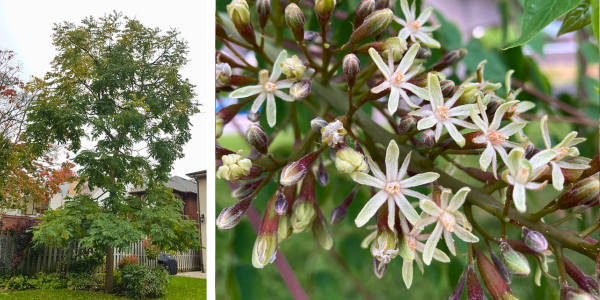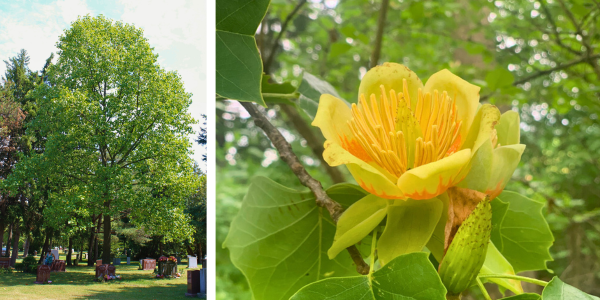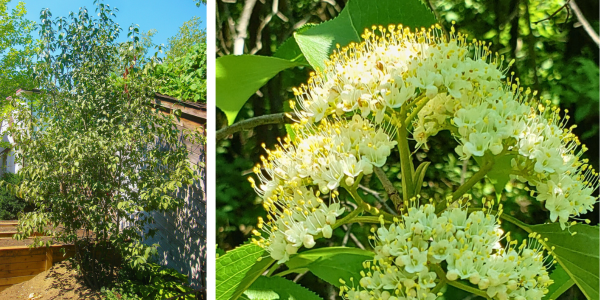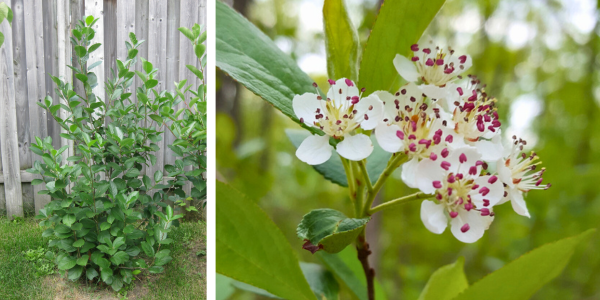Kentucky coffee tree Gymnocladus dioicus

The Kentucky coffeetree is a captivating and resilient species known for a number of unique characteristics. Its distinctively large leaves are among the largest in North America. Each leaf is composed of several ovate leaflets, which are further subdivided into even more leaflets, totaling about 70 in all. Beyond aesthetics, this tree boasts a fascinating historical significance; early settlers reportedly roasted its seeds as a coffee substitute, hence its name. The Kentucky coffeetree is hardy and adapts well to many harsh growing conditions, making it an ideal tree to plant in urban areas.
The Kentucky coffeetree is dioecious, meaning individual trees have either male or female flowers. Long, greenish-white flowers emerge in June, which attracts a diverse array of pollinators, including bumblebees and digger bees, along with butterflies like the eastern tiger swallowtail butterfly. The flowers are also visited by the ruby-throated hummingbird! All of these pollinators play a crucial role in cross-pollination.
Tulip tree Liriodendron tulipifera

The tulip tree is a fascinating species known for its towering height, reaching up to 90 feet or more. It has smooth, light-grey bark when young that gradually develops a ridged, grey-brown bark as it matures. The light-green leaves resemble tulip cups or a whale's tail and transform into a magnificent yellow in autumn. It prefers growing in full sunlight in well drained, sandy-loam soils and makes for a great shade tree when mature.
One of the most distinctive features of the tulip tree is its tulip-like flowers, which bloom in June and are a striking yellow-green with orange at the base. Bumble bees and long-tongued bees are attracted to these large, showy flowers, which provide them with a rich, abundant and easily accessible source of nectar and pollen. Ruby-throated hummingbirds also visits tulip trees to feed on nectar.
Nannyberry Viburnum lentago

The nannyberry is a wonderful shrub with numerous attractive features. It grows well in both full or partial sun and can grow in all soil types. It has dense foliage and can form a dense thicket if allowed to sucker, which makes it ideal for those seeking privacy in their outdoor spaces. Its fall fruit is highly sought after by a variety of birds, and if harvested promptly, the delicious fruit can be enjoyed fresh or used for baking.
Another lovely feature of nannyberry shrubs is the delicate clusters of fragrant, creamy-white blossoms that begin blooming in late May. These flowers are not only visually stunning but also provide a bountiful and irresistible source of nectar and pollen that attract a diverse array of pollinators, especially for mining bees and sweat bees, but also for long-tongued bees and other pollinators.
Black chokeberry Aronia melanocarpa

Black chokeberry is an excellent choice for yards and reaches a maximum height and width of eight feet. It has simple, dark green leaves that turn beautiful shades of orange and red in fall. The shrub's berries serve as an important food source for migrating birds in fall. Since it thrives in full or partial sun and is adaptable to various soil conditions, black chokeberry proves to be a versatile and visually appealing addition to any garden space.
Black chokeberry flowers bloom from May to June, and while individually small, they are abundant. Their small white blossoms are arranged in charming 5-petaled clusters. These delicate blooms play a crucial role in the garden ecosystem, attracting a diverse range of pollinators like bumblebees and smaller bees like sweat bees, mining bees and mason bees.
Check out Part 1 of this series to learn about early spring blooming native trees and shrubs that attract bees. By planting native trees and shrubs in your yard, you will be promoting Backyard Biodiversity and supporting the lifecycle of our native bees. Ready to get started? Plant for less through our subsidized Backyard Tree Planting Program! Check out our Homeowners page to get started on native tree planting and our Shrubs page to order native shrubs.
Justin Lewis is the Marketing and Communications Lead at LEAF.
The #BackyardBiodiversity campaign is a partnership initiative with the Toronto Wildlife Centre and is supported by Ontario Power Generation.
LEAF offers a subsidized Backyard Tree Planting Program for private property. The program is supported by the City of Toronto, the Regional Municipality of York, the City of Markham, the Town of Newmarket, the Regional Municipality of Durham, the Town of Ajax, the Township of Brock, the Municipality of Clarington, the City of Oshawa, the City of Pickering, the Township of Scugog, the Town of Whitby and Ontario Power Generation.
